4.5 - Generative Metrics
Assuming that you have immersed yourself in Attridge's beat-offbeat method, it may seem like changing horses in midstream to return now to generative metrics. Fortunately, having worked through the assignment of trees in the Versification section, it is short work now to learn how to compare the stress pattern to the metrical pattern and to see how the generative approach deals with complexity and tension. Also, section 4.4 on Elision, Caesura and Enjambment, is equally applicable to both methods and in fact, the syntactic emphasis of the generative approach should make some aspects of enjambment clearer. After showing you how to use the generative approach, I will also offer a brief comparison of the two methods.
Having marked syntactic phrases with square brackets and indicated the stress and stress trees for all the words and phrases in a line of verse, you are ready to compare the stress patterns with the abstract metrical pattern. Instead of Attridge's o B o B o B o B o B pattern to represent iambic pentameter, generative metrics uses a set of five w s units, each grouped together by a bracket (in conventional analysis, each of these units would be called a foot). The foot units of the abstract metrical norm are notated below the line. By comparing the two patterns, tension-producing bracketing and labeling mismatches can be clearly perceived. "Labels" refers to the w and s patterns above and below the line. "Brackets" refers to the lines connecting the metrical pattern below the line and the stress pattern of the syllables and words above the line. A completely regular line will match the s's of the stress pattern to the s's of the metrical pattern (likewise w's to w's) as well as matching the brackets of the verse instance with the abstract pattern, as in Example 23.
(23)
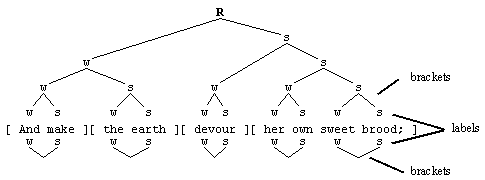
As you know from your work with the Attridge system, few lines are as regular as this one. Generative metrics measures complexity, i.e., deviations from this normative pattern, in terms of bracketing and labeling mismatches. In general, the greater the number of mismatches, the more complex a line tends to be. A BRACKETING MISMATCH occurs when the bracketing of the particular verse instance violates, at the first level of tree structure, the boundaries of the iambic feet shown below the line. I circle each metrical foot below the line to show where a violation occurs, as in Example 24, which has four bracketing mismatches.
(24)
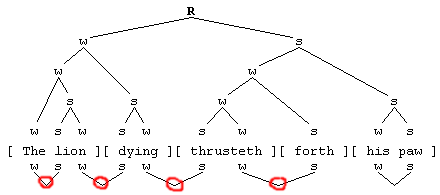
A LABELING MISMATCH is produced when an s in the stress pattern occurs in a w position of the metrical pattern or a w in the stress pattern occurs in an s position of the abstract metrical norm. As you might suppose, an s occupying a w metrical position is far more disruptive than a w in an s position. If you think back to Attridge's complexity rules, you will see that such features as demotion and the implied offbeat both involve a stressed syllable in a weak metrical position. Thus, though Attridge and the generative approach start from different assumptions, both systems of analysis give this type of complexity a similar place in their analyses. As you will see in a moment, the generative approach also reflects aspects of complexity that the Attridge system overlooks. But staying for the moment with their points of similarity, take this line from Shelley's "Ozymandias" which you analyzed in Exercise #8. Attridge sees the source of the deviations in this line as the implied offbeat / double offbeat combination; in generative terms the complexity is produced by the labeling and bracketing mismatches. You may want to compare your analysis here with your analysis in Exercise #8.
(25)
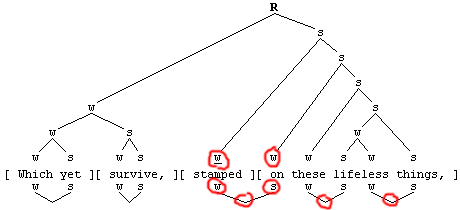
Determining the number and kinds of mismatches in a given line allows one to measure a line's complexity and often its greatest points of interest in terms of the poem's meaning. Before looking at some more complicated examples, try practicing some lines with straightforward bracketing and labeling mismatches. The greater the number of mismatches, the more complex the line is considered to be.
Scan these lines using the generative approach, including brackets for the syntax and complete tree structures.
Nobler desires, lest else that friendly foe,
They also serve who only stand and wait.
Some mismatches, like the reversed initial foot (as in Exercise #10a), are harmless and occur frequently with little disruption of the pentametric norm. However, it is possible to take mismatches to the point of unmetricality. "Unmetricality" is the rhythmic equivalent of an ungrammatical expression; in the context of poetry, think of it not so much as an expression that shouldn't occur but as one that marks the limits of metrical constraint. A line is UNMETRICAL when an s in the verse instance occurs in a metrical w position simultaneously with a bracketing mismatch. Notice that this rule does not preclude a w occurring in a metrical s position with a simultaneous bracketing mismatch. This rule about unmetricality is useful not so much because it tells us about something that shouldn't happen; rather, when an unmetrical line occurs, it is almost always marks a highly significant semantic point in the poem. Consider these two examples:
(26a)
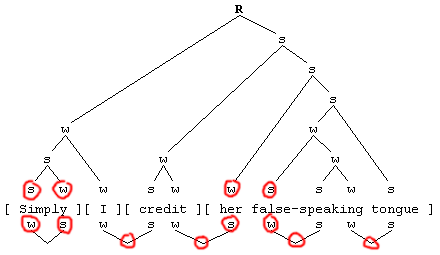
(26b)
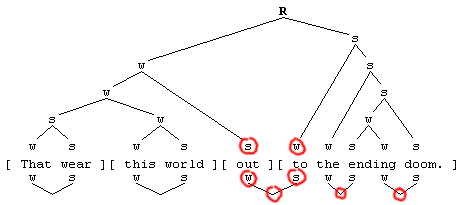
In the first example, the unmetricality comes from the compound, "false-speaking," which forces the consecutive stressed syllables and whose bracketing simultaneously cuts against the metrical pattern. Not accidentally, this unmetrical instance occurs in a sonnet about the truth and falsity of love and lovers and gives our ears a stinging dissonance on the lover's "false-speaking tongue." The second example comes from a sonnet where Shakespeare extols the virtues of his lover who, by virtue of his poetry, can outlive the onslaughts of time as well as the judgments of men. "Your praise," he tells his love, "shall still find room / Even in the eyes of all posterity / That wear this world out to the ending doom." The unmetricality occurs here at the point of collision between the asserted eternality of love and poetry and the certain transience of the world, of life and language itself.
The following exercise gives you practice with some unmetrical lines. Beyond figuring out why they are unmetrical in a narrowly analytical sense, you may want to read them in the context of the poems, thinking about what effect these lines have within the poems.
Scan these lines using the generative approach, including brackets for the syntax and complete tree structures.
Batter my heart, three-personed God; for you
That mine own writings, like bad servants, show